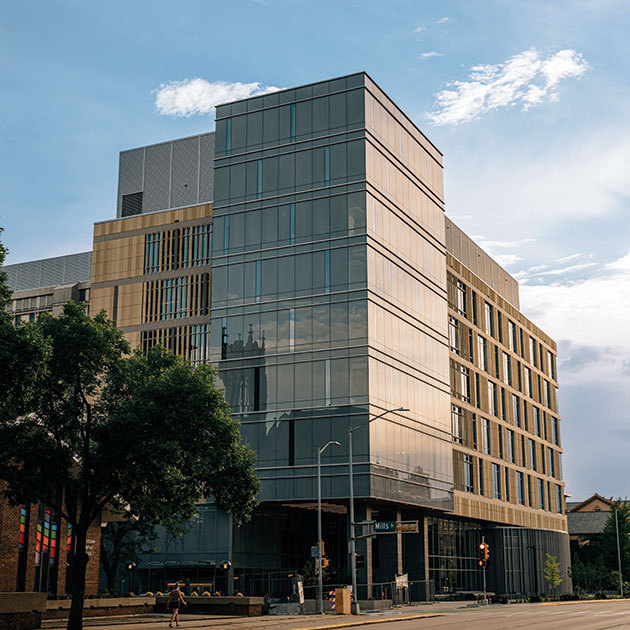This story appeared in the Fall 2021 Letters & Science magazine.
*Updated 2/3/2022: The Chemistry Tower opened in January 2022.
The Department of Chemistry had a problem, and its name was Chemistry 344. In some ways, it was a good problem—the basic organic chemistry laboratory course fulfilled a requirement for UW’s undergraduate students, and with more and more of them gravitating toward STEM degrees, the chemistry undergraduate program was attracting upwards of 7,000 students per semester. The bad news was that the current instructional facilities in the 1960s-era Daniels Building were ill-suited to accommodate them, while the Shain Tower, built in 2000, was designed for research. The result: a massive enrollment bottleneck.

Despite chemistry faculty and staff offering courses almost around the clock, nearly 20 percent of undergraduates were forced to take Chemistry 344 somewhere other than on the UW-Madison campus—in some cases, as far away as UW-Whitewater. And more and more students were forced to delay graduation because they couldn’t access the course.
“The enrollment pressure was tremendous,” says Robert McMahon, the former chair of the department and member of the building committee for the new Chemistry Tower. “And the truth was, many of our incoming freshmen, coming to UW’s flagship campus, had better lab facilities in their high schools.”
Now that problem will be solved, with a state-of-the-art new building that’s just been completed. For more than a decade, campus leaders and UW supporters lobbied and fundraised for new facilities to better meet students’ needs. In 2015, the Wisconsin state legislature agreed to provide $90 million of the tower’s $135 million price tag as part of the 2016 state budget, leaving the remaining $45 million to be raised by UW.
With UW-Madison Chancellor Rebecca Blank leading the charge, the campus and donor community stepped up in a major way. Most of the donations came from individuals who had no direct connection with the Department of Chemistry. Instead, they came from what McMahon calls “the great cast of campus stewards.”
“The new Chemistry Tower is really a testament to the power of our campus community to recognize a problem and then join together to find a successful solution,” Blank says. “Ensuring that we can meet the evolving instructional needs of our students goes to the very heart of our mission at UW-Madison, and that’s exactly what this project accomplishes.”
The new tower accomplishes, but it also astonishes. Entering from Mills Street, the first thing visitors see is a grand staircase, split into twin pathways of red and white marble terrazzo. Those stairs lead down to a sub-basement where two oversized lecture halls, equipped with state-of-the-art technology and named in honor of supporters John and Tashia Morgridge, seat 362 and 250 students, respectively. The space outside the lecture halls has been designed to encourage student and teacher interaction between classes, something that couldn’t occur organically in the old space. The walls are adorned with erasable glass boards to capture post-class notes and chemical formulas. Around the corner, a large and well-stocked lecture demonstration area allows class assistants to stock carts with the proper chemicals and equipment and wheel them in to waiting instructors less than 50 yards away.
The tower’s fifth and sixth floors are where the bottleneck issue really gets addressed. Five organic chemistry labs and an organic synthesis lab feature enough space to accommodate students, and there are individual “write-up rooms” where students can capture data and take notes. The ’60s-era stations have been upgraded as well — for example, each lab station features a transparent fume hood instead of the old metal hoods.
“Rather than having a feeling of standing in a canyon, surrounded by these metal boxes, these stations have a remarkably open appearance and feel,” says McMahon. “After all these years, we’re setting a national standard for how chemistry labs will be designed and conducted.”
The tower also includes a new Undergraduate Special Projects Lab, designed to allow students to get experience conducting smaller research projects with chemistry faculty and staff.

One of the most important new features is a multipurpose learning studio that can be used for classes, poster sessions and receptions. John Moore, the emeritus professor of chemistry who advised the building commission on curricular issues, is excited about this. The space’s active learning components dovetail nicely with the Redesigning for Active Learning in High-Enrollment Courses (REACH) Initiative, a project the chemistry department has been spearheading since 2018.
“In a room like this, I could go back and forth between lecturing and having students work in groups,” says Moore. “In the old space, we had to schedule these activities on different days and in different buildings.”
On the second floor, the Phillip W. Gross Information Commons takes the concept of a chemistry library almost entirely virtual. Instead of rows of bookshelves, there are both enclosed study rooms and open public study spaces, encouraging multiple types of interactions.
“We became the poster child for the library of the future when we were designing it, because the library system was moving all their books, repositories and bound journals online as we were doing this,” explains Moore.
The hotly anticipated Chemistry Tower is expected to be open to students at the start of spring semester 2022. Attention then turns to renovating three floors of the Daniels Building, which houses multiple floors of general chemistry labs, undergraduate program offices and meeting rooms. Over the next year, it will be modernized into the permanent home of the general chemistry programs.
“We still have a couple of years’ worth of work ahead of us,” says McMahon. “Although obviously we’ll have a much less dramatic scale than building a whole new tower.”



